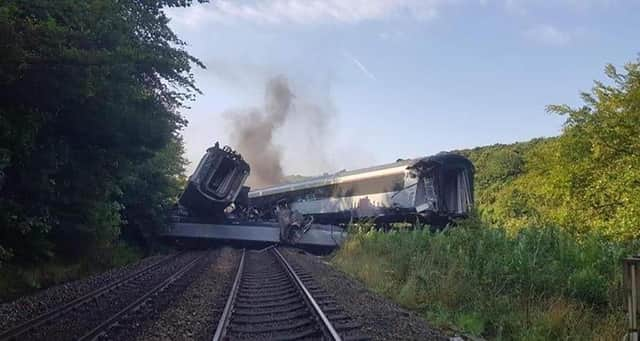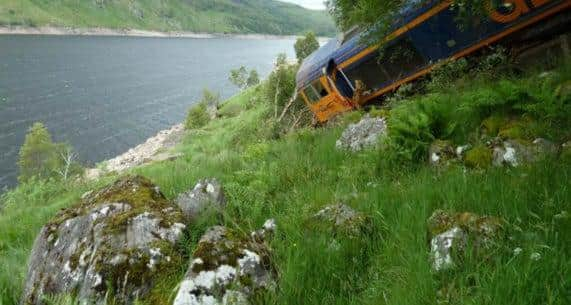Grim prospects for Scotland's railways from extreme weather - Alastair Dalton


Following the Hatfield disaster in 2000, in which four people were killed, the railways led the news every night for weeks.
It came barely a year after 31 died at Ladbroke Grove in West London, and was to be followed by multiple fatality incidents among passengers in 2001, 2002, 2004 and 2007.
I came to dread the next one.


The very last type of story I would want to cover.
Advertisement
Hide AdAdvertisement
Hide AdBut for the last 13 years, there had been no more deaths on trains, and I started tentatively writing about the railways’ improving safety record.
There have been other fatalities in the interim, but involving vehicles on level crossings and track workers being hit by trains, and a passenger falling between the platform and a train.
‘Disbelief’


So when an industry contact alerted me to a “major derailment” near Stonehaven last week, it did not cross my mind initially there might be loss of life, let alone the train’s driver, conductor and one of its passengers all being killed.
The first pictures we received of the wrecked carriages, one on top of another, I also met with disbelief and I took some time checking they were not from some entirely different crash.
However, in the aftermath of the incident, when investigators confirmed the train had hit a landslip, came the horrible realisation that extreme weather – just like maintenance failings in the past – could bring death to Scotland’s railways.
First such crash since 1914


It is thought to be the first fatal train crash in Scotland caused by the weather for more than a century, after five drowned following a bridge collapse near Carrbridge in 1914 due the sudden increase in the water level following a storm.
However, it’s not as if we haven’t been warned, in a series of incidents over recent years that thankfully didn’t result in serious injury.
Ten years ago, a ScotRail train nearly plunged down a 50ft embankment after hitting fallen boulders and derailing at Cruachan on the Oban line.
Advertisement
Hide AdAdvertisement
Hide AdTwo years later, another ScotRail train hit debris from a landslide near the same location, and a freight locomotive plunged down a slope near Corrour on the Fort William route.


Enforcement action
The incidents, among at least eight in a year, led to the Office of Rail and Road regulator taking formal safety enforcement action to make track owner Network Rail improve its assessment of landslip risks.
The then transport minister Keith Brown also ordered a “much more structured” analysis of the problem.
Network Rail responded by saying it was “confident we can put in place even more robust plans for the management of our infrastructure”.
There have been similar incidents since, and more official warnings, including a month ago.
But the scale of the challenge was highlighted in 2018 when a ScotRail train hit a huge landslip near Glenfinnan on the Mallaig line which had ploughed through a new protective fence.
Meantime, flooding from a canal burst at Polmont which could see the main Edinburgh-Glasgow line shut for two months was caused by a “one-in-240-years storm”, according to Scottish Canals yesterday.
Heightened inspections
In the wake of last week’s derailment, Network Rail vowed to implement immediate extra safety measures such as “heightened inspections” at high-risk sites, and accelerating remote monitoring plans.
Advertisement
Hide AdAdvertisement
Hide AdHowever, Scotland’s rail network covers 1,750 miles, and many of the trouble-spots lie outside its boundaries.
For a previously booming industry already reeling from Covid-19, the potential implications of more devastating weather like the conditions Scotland experienced last week are dauntingly serious.
A message from the Editor:
Thank you for reading this story on our website.
While I have your attention, I also have an important request to make of you.
With the coronavirus lockdown having a major impact on many of our advertisers - and consequently the revenue we receive - we are more reliant than ever on you taking out a digital subscription.
Subscribe to scotsman.com and enjoy unlimited access to Scottish news and information online and on our app.
With a digital subscription, you can read more than 5 articles, see fewer ads, enjoy faster load times, and get access to exclusive newsletters and content.
Visit https://www.scotsman.com/subscriptions now to sign up.
Our journalism costs money and we rely on advertising, print and digital revenues to help to support them.
By supporting us, we are able to support you in providing trusted, fact-checked content for this website.
Joy Yates
Editorial Director
Comments
Want to join the conversation? Please or to comment on this article.